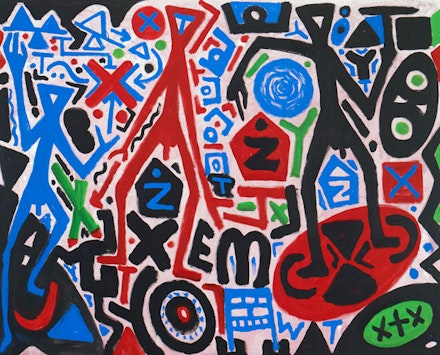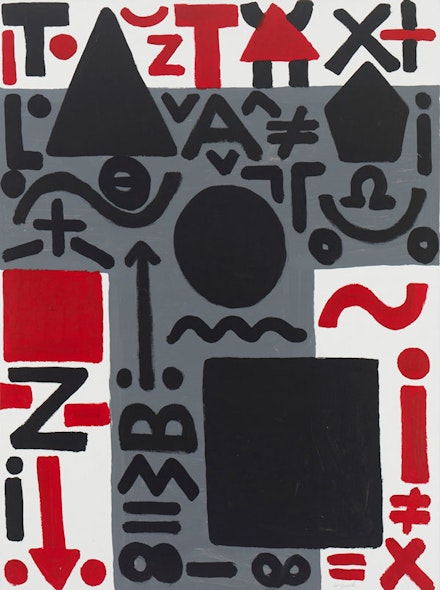ArtSeen
A.R. PENCK New Paintings
On View
Michael Werner GalleryJanuary 10 – March 8, 2013
London
A.R. Penck has been part of the German imagination since the early 1960s, when his interest in information systems and all manner of signs was ahead of its time. He is a painter of uncommon intelligence and ambition, working out his own idiom of pictographs and abstract symbols meant to shed light on the way we share information. His language has become more and more sophisticated as time has worn on, with images fitting neatly within his compositions and interlocking almost as a finished puzzle might, so that his naked male personages move beyond symbolism and into the terrain of common humanity. The new works, which include a couple of brightly hued paintings, represent not a diminishment but rather, a continuation of communicative signs that refuse to spell out an actual message while retaining the visual interest of specific information. Penck, also active as a writer, knows that his audience will try to puzzle out his allegorical emblems, which may well portray a world of common significance.
The paintings themselves are crowded with imagery: in “Vorstab (Advance)” (2010), one recognizes letters and mathematical signs—xes and arrows—painted mostly in black against blocks of gray and white. They extend the promise of a meaningful message, but exactly what is being said is impossible to unravel. This undermining of language’s ability to mean something while coding it in an attractive form looks like a recognition of communist miscommunication, surely an issue when Penck was living in Dresden and East Berlin during Germany’s pre-unification period. The function of language in East Germany inevitably became suspect in the grips of a utopian, but failed, society; in response, Penck both builds and sabotages his vernacular in ways that image a damaged paradise of the present moment, if not a classless state. This intention shows up well in “Advance,”where everything is found in an abstract order that leaves nothing to chance. We infer that this is not necessarily a good thing.
“Dreigeteiltes Problem (Tripartite Problem)” (2011) consists of three schematic, naked male figures in blue, red, and black. They are surrounded by mazes of symbols and abstract designs, which disorient the viewer as he or she puzzles over equations whose make-up is visual rather than content oriented. The combinations of red, black, green, and blue are skillfully handled and construct hierarchies of relations that extend abstractly into the artist’s pictorial space. Yet the space cannot be seen as completely nonobjective; the three men with openly displayed genitals complete the meaning of the painting’s title. Even so, if Penck’s audience remembers that the picture represents a problem, we see that the triumvirate’s presence is philosophical at least as much as it is human. But again, it is hard to tell whether the difficulty carries weight beyond the visual significance of the figures’ placement.
In the work “Eröffnung (Opening)” (2010), the number of pictograms has been reduced; it really is an abstract work of art, possibly suggesting the reductive forms of Suprematism. At the same time, it is a postmodern work, and looks ahead, with its red and black squares and lines, dots and triangles, to a plausible universality of visuals. We remember this universality as common ground. It is hoped that Penck, not given too many recent shows in America, will become more familiar to us in the future.



